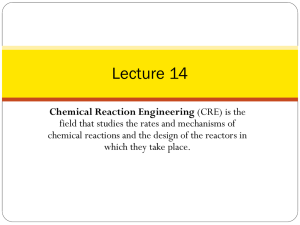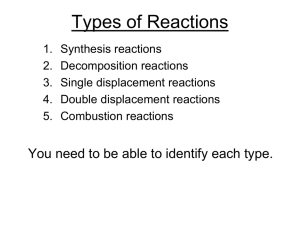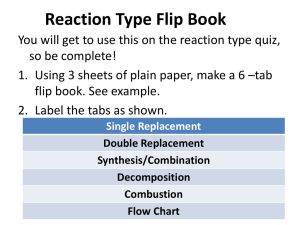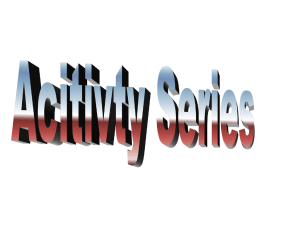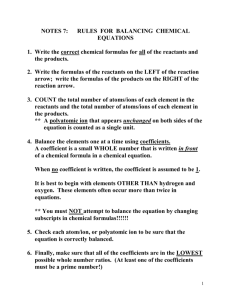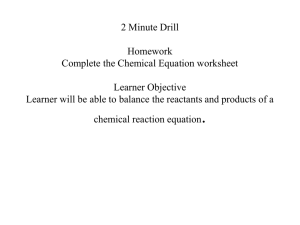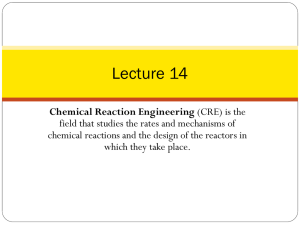Single Replacement Reactions: High School Chemistry Lesson
advertisement
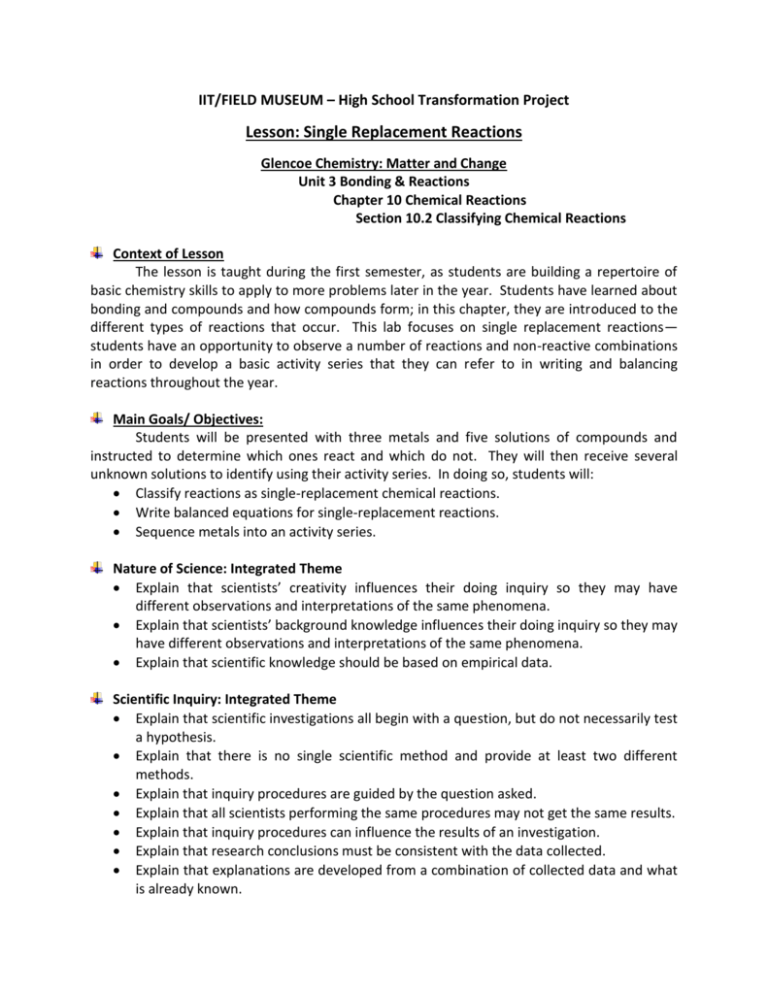
IIT/FIELD MUSEUM – High School Transformation Project Lesson: Single Replacement Reactions Glencoe Chemistry: Matter and Change Unit 3 Bonding & Reactions Chapter 10 Chemical Reactions Section 10.2 Classifying Chemical Reactions Context of Lesson The lesson is taught during the first semester, as students are building a repertoire of basic chemistry skills to apply to more problems later in the year. Students have learned about bonding and compounds and how compounds form; in this chapter, they are introduced to the different types of reactions that occur. This lab focuses on single replacement reactions— students have an opportunity to observe a number of reactions and non-reactive combinations in order to develop a basic activity series that they can refer to in writing and balancing reactions throughout the year. Main Goals/ Objectives: Students will be presented with three metals and five solutions of compounds and instructed to determine which ones react and which do not. They will then receive several unknown solutions to identify using their activity series. In doing so, students will: Classify reactions as single-replacement chemical reactions. Write balanced equations for single-replacement reactions. Sequence metals into an activity series. Nature of Science: Integrated Theme Explain that scientists’ creativity influences their doing inquiry so they may have different observations and interpretations of the same phenomena. Explain that scientists’ background knowledge influences their doing inquiry so they may have different observations and interpretations of the same phenomena. Explain that scientific knowledge should be based on empirical data. Scientific Inquiry: Integrated Theme Explain that scientific investigations all begin with a question, but do not necessarily test a hypothesis. Explain that there is no single scientific method and provide at least two different methods. Explain that inquiry procedures are guided by the question asked. Explain that all scientists performing the same procedures may not get the same results. Explain that inquiry procedures can influence the results of an investigation. Explain that research conclusions must be consistent with the data collected. Explain that explanations are developed from a combination of collected data and what is already known. General Alignment to Standards State Goal 11: Understand the processes of scientific inquiry and technological design to investigate questions, conduct experiments, and solve problems. A. Know and apply the concepts, principles and processes of scientific inquiry. ILS 11.A.4a Formulate hypothesis referencing prior research and knowledge ILS 11.A.5b Design procedures to test the selected hypotheses. ILS 11.A.4c Collect, organize and analyze data accurately and precisely 11.A.4e Formulate alternative hypotheses to explain unexpected results State Goal 12: Understand the fundamental concepts, principles and interconnections of the life, physical and earth/space sciences. C. Know and apply the concepts that describe properties of matter and energy and the interactions between them. ILS 12.C.3b Model and describe the chemical and physical characteristics of matter. Materials For bell ringer demonstration: Copper wire (about 10 cm) Aluminum foil (10 cm square) 200 mL 0.50 M copper (II) chloride solution 200 mL 0.50 M aluminum chloride solution 4 400 mL beakers Per student: Lab notebook Student lab sheet For each group of 2 students: Micro-well plate (24 wells) Forceps 5 dropper bottles or 5 beakers and 5 labeled pipettes (These may be shared by 2 or 3 lab groups working at the same table) Small pieces (5-10 mm squares cut from sheets or strips) of copper, zinc, and magnesium (5 each) Approx. 2 mL of each 0.20 M solution: o copper (II) nitrate o magnesium nitrate o silver nitrate o zinc nitrate Approx. 2 mL of 3.0 M hydrochloric acid solution Supplies to be made available to all students/class Waste beakers for solids, acid, and silver solutions Preparation Make sure the pieces of copper, zinc, and magnesium are small enough to fit into the wells of the micro-well plate. To prepare 200 mL of each 0.50M solution, dissolve the amount of compound listed below in enough distilled water to make 200 mL of solution. o CuCl2……….....dissolve 13.45g o AlCl2…………...dissolve 13.33g To prepare 200 mL of each 0.20M solution, dissolve the amount of compound listed below in enough distilled water to make 200 mL of solution. o Cu(NO3)2……….....dissolve 7.05g o Mg(NO3)2………....dissolve 5.93g o AgNO3……………….dissolve 6.79g o Zn(NO3)2……………dissolve 7.58g To prepare 3M HCl, add 50ml of concentrated 12M HCL to 150mL of distilled water. Place the solutions in labeled dropper bottles (at least 3 bottles of each solution, distributed around the lab) or in labeled beakers. If using beakers, then label dropper pipettes (one pipette per solution, per lab group) by wrapping masking tape or labeling tape around the neck of the pipette to make a flag, as shown at right. Write the solution’s formula on the flag with permanent marker. This is to prevent cross-contamination of solutions. Dropper bottles reduce the risk of crosscontamination. Before students arrive, prepare the demonstration for students to view. Pour 50 mL of CuCl 2 solution into a beaker and place a crumpled ball of aluminum foil in the solution. The aluminum will quickly begin to react and copper metal will be visible on the foil. Place 50 mL of AlCl3 solution into another beaker and place a piece of copper wire into the solution. No reaction will occur. Place these beakers on a table near the door where students will enter. So that students can see how the reactants started, place beakers of the two solutions beside the reaction beakers, but leave the aluminum foil and copper wire beside the beakers. Write on the board: CuCl2(aq) + Al(s) Cu(s) + AlCl3(aq) AlCl3(aq) + Cu(s) No Reaction “Why is there no change occurring in the beaker containing copper wire and aluminum chloride solution?” The Lesson Bell Ringer Instruct students to view the reactions as they enter and have them write a description of their observations in their notebooks, then have them answer the question on the board. Encourage students to write down ideas even if they are not sure of the answer. Begin lesson by reminding students of the chemical reaction types they have learned about: synthesis, single replacement, double replacement, decomposition, and combustion. Tell them that today’s lab will focus on single replacement and remind them that a single replacement reaction always occurs between an element and a compound. As they have seen in the demonstration, not every element-compound pair will react because some elements are more reactive than others. If the more reactive substance is the element, a reaction will occur, but if the more reactive substance is in the compound, no reaction will occur. Distribute the lab sheets and allow students a few moments to read them. Point out to students that they must make sure to test each metal with each solution listed. Demonstrate the use of a micro-well plate and dropper pipette if students have not used them before. Emphasize the importance of not mixing up the dropper pipettes. Ask students how they will know if a reaction has taken place. (If they do not list color change, solid precipitate, and bubbles, mention these.) Remind students that some reactions occur quickly, while others take longer. Review for students the relevant lab safety measures—they must wear goggles, avoid getting any solutions on their skin or clothing, clean up spills immediately, read labels carefully, follow directions for disposal and wash their hands after the lab. Divide students into pairs and allow them to do the lab activity. Move among students as they work, observing their procedures, lab techniques, observations and answers. As necessary, pose questions to make students observe more carefully or think more deeply about what they are observing. Ask questions such as, “What’s going on in this well? Why?” Asking students to predict what will happen as they are about to combine two substances is especially indicative of how well they understand the idea of activity series. Make sure to interact with each group at least once or twice during the lab. Be alert for students who are not following the safety guidelines and remind all students to dispose of their chemical wastes correctly. When most students have completed the lab and cleaned up their work areas, gather the class back at their desks. Review students’ observations and discuss their conclusions. Ask groups to share their activity series and explain the reasoning that they used in forming them. Emphasize that their conclusions are based upon empirical data—their observations—and that they rely upon both new observations and prior knowledge. Ask what challenges students encountered as they performed the lab and allow students to comment on one another’s procedures, conclusions and challenges. Homework Students should analyze their data and construct an activity series including all of the cations (copper, magnesium, zinc, hydrogen, silver, and aluminum) observed in class. They should write equations for the single replacement reactions they observed and answer the lab question. Modifications/Accommodations If limited class time is available, allow students to read the lab sheet and devise a procedure as homework the night before the lab. Students who have difficulty organizing their observations may benefit from a blank data table on which they can label the rows and columns. For students who have difficulty writing chemical equations, an example equation may be provided. For an extra challenge, the metals and solutions can be labeled with letters as shown. Students may then use a prepared activity series (see page 288 of the textbook) to determine the identity of each metal and solution. In this case, students must be instructed to treat all solutions with extreme care and must receive item-by-item instructions for disposal. Copper: A Magnesium: B Zinc: C Copper (II) nitrate: ASO4 Magnesium nitrate: BNO3 Zinc nitrate: CNO3 Hydrochloric acid: DCl Silver nitrate: ENO3 As a last resource the laboratory investigation can be performed as a virtual lab. www.chem.iastate.edu/group/Greenbowe/sections/projectfolder/flashfiles/redox/home .html Activity 1 and Activity 4 perform the same investigations as the model lesson. Assessment Students’ achievement of the objectives will be assessed by observing their work in lab, their answers to the lab questions, their answers to questions during the discussion after lab and their work on test questions about single replacement reactions. Single Replacement Reaction Laboratory Investigation One important category of reactions is the single replacement reaction. These reactions have an element and a compound as reactants. After the reaction, the original element has become part of a new compound while one of the elements in the original compound is present in the elemental state. The equation may look something like this: A (S) + C3B (aq) A2B (aq) + C (S) The reactivity of a substance depends on its ability to gain or lose electrons. It is possible to arrange the elements into a series based upon their reactivity. This is called an activity series. While there are many types of replacement reactions, in this lab we will investigate two different types of reaction. In one type, a more active metal replaces a less active metal from solution. Consider the reaction between iron (Fe) and copper (II) sulfate (CuSO4) Fe (S) + CuSO4 (aq) FeSO4 (aq) + Cu (S) In this reaction, the more active iron (Fe) replaces the less active copper (Cu) from solution. The reaction is evident because the blue color of the copper (II) sulfate (CuSO4) solution slowly turns colorless and a deposit of copper can be seen to form on the strip of iron. Fe (S) + HCl (aq) FeCl2 (aq) + H2 (g) A second type of replacement reaction involves the replacement of hydrogen from acid by a metal. Consider the reaction between iron (Fe) and hydrochloric acid (HCl). Bubbles of hydrogen gas can be seen rising to the surface and the piece iron (Fe) is consumed. On the other hand, if the less active metal, copper (Cu), is placed into a hydrochloric acid (HCl) solution, no reaction will take place. In this lab, you will try several combinations of elements with compounds to observe evidence of reaction. You will then determine the activity series for the metals you use and write the balanced equation for the reactions that occur. Since you will be working with acid and other solutions (notably silver nitrate, which can cause skin burns with a single drop), you must wear lab goggles and follow the lab safety guidelines very carefully. Single Replacement Reaction Laboratory Investigation Procedures Name: _______________________________________________ Period: __________ Cu Mg Zn Materials: Micro-well plate Cu(NO3)2 5 Dropper pipets Five (5) pieces of: Mg(NO3)2 o Copper (Cu) o Magnesium (Mg) Zn(NO3)2 o Zinc (Zn) 2 ml of the following solutions o copper (II) nitrate (Cu(NO3)2) AgNO3 o magnesium nitrate (Mg(NO3)2) o zinc nitrate (Zn(NO3)2) HCl o silver nitrate (AgNO3) o hydrochloric acid (HCl) Procedure: Place the micro-well plate on top of a white piece of paper and label each row and column as example provided above. Add about 10 drops, enough to fill the well half way, of each aqueous solution to the appropriate wells. Be very careful not to mix up the pipettes, or the solutions will become contaminated and you won’t know what is or is not reacting! Place a small piece of each metal into the labeled wells. Observe and record any indication of a chemical reaction. If no sign is noticeable immediately, wait 10 minutes and then reexamine the test tube. Record any changes. Clean up: Use forceps to remove any remaining pieces of solid metal from the wells. Place the solids in the beaker labeled “Waste solids.” Pour the all the solutions containing SILVER ions into the beaker labeled “Waste AgNO3” Pour the all the solutions containing HCl into the beaker labeled “Waste acid” The remaining solutions may be rinsed down the drain with plenty of water. Write up: Using your observations of which combinations produced reactions and which did not, construct an activity series that includes all of the metals (and hydrogen) that you used in lab today. The most reactive metal should be at the top of the list. Write the chemical equation for each reaction, if no reaction was observed write no reaction for the product. Be sure that you have written the correct formula for each of the compounds formed in the reactions. Then balance the equation. If zinc does react with a solution of Co(NO3)2, will a reaction occur when cobalt is mixed with a Zn(NO3)2 solution? Explain your reasoning. Name: _______________________________________________ Period: __________ On the table below indicate your observations. If a chemical reaction is observed, write Reaction, if a chemical reaction is not observed, write No Reaction. Activity Series for Cu, Mg, Zn, Ag, and H Single Replacement Data Table Cu Mg Zn Most Active Cu(NO3)2 Mg(NO3)2 Zn(NO3)2 Least Active AgNO3 HCl Using the data collected; complete and balance each of the following equations. If no reaction was observed, write no reaction. 1. ___ Cu (S) + ____ Cu(NO3)2 (aq) ____________________________________ 2. ___ Cu (S) + ____ Mg(NO3)2 (aq) ____________________________________ 3. ___ Cu (S) + ____ Zn(NO3)2 (aq) ____________________________________ 4. ___ Cu (S) + ____ AgNO3 (aq) ____________________________________ 5. ___ Cu (S) + ____ HCl (aq) ____________________________________ 6. ___ Mg (S) + ____ Cu(NO3)2 (aq) ____________________________________ 7. ___ Mg (S) + ____ Mg(NO3)2 (aq) ____________________________________ 8. ___ Mg (S) + ____ Zn(NO3)2 (aq) ____________________________________ 9. ___ Mg (S) + ____ AgNO3 (aq) ____________________________________ 10. ___ Mg (S) + ____ HCl (aq) ____________________________________ 11. ___ Zn (S) + ____ Cu(NO3)2 (aq) ____________________________________ 12. ___ Zn (S) + ____ Mg(NO3)2 (aq) ____________________________________ 13. ___ Zn (S) + ____ Zn(NO3)2 (aq) ____________________________________ 14. ___ Zn (S) + ____ AgNO3 (aq) ____________________________________ 15. ___ + ____ HCl (aq) Zn (S) ____________________________________ Name: _______________________________________________ Period: __________ On the table below indicate your observations. If a chemical reaction is observed, write Reaction, if a chemical reaction is not observed, write No Reaction. Activity Series for Cu, Mg, Zn, Ag, and H Single Replacement Data Table Cu Mg Zn Cu(NO3)2 No Reaction Reaction Reaction Mg(NO3)2 No Reaction No Reaction No Reaction Zn(NO3)2 No Reaction Reaction No Reaction Reaction Reaction Reaction No Reaction Reaction Reaction AgNO3 HCl Most Active Mg Zn Cu Ag Least Active Using the data collected; complete and balance each of the following equations. If no reaction was observed, write no reaction. 1. ___ Cu (S) + ____ Cu(NO3)2 (aq) No Reaction 2. ___ Cu (S) + ____ Mg(NO3)2 (aq) No Reaction Cu (S) + ____ Zn(NO3)2 (aq) No Reaction 4. ___ Cu (S) + ____ AgNO3 (aq) Cu(NO3)2(aq) + Ag(S) 5. ___ Cu (S) + ____ HCl (aq) No Reaction 6. ___ Mg (S) + ____ Cu(NO3)2 (aq) Mg(NO3)2(aq) + Cu(S) 7. ___ Mg (S) + ____ Mg(NO3)2 (aq) No Reaction 8. ___ Mg (S) + ____ Zn(NO3)2 (aq) Mg(NO3)2(aq) + Zn(S) 9. ___ Mg (S) + ____ AgNO3 (aq) Mg(NO3)2(aq) + Ag(S) 10. ___ Mg (S) + ____ HCl (aq) MgCl2(aq) + H2(g) 11. ___ Zn (S) + ____ Cu(NO3)2 (aq) Zn(NO3)2(aq) + Cu(S) 12. ___ Zn (S) + ____ Mg(NO3)2 (aq) No Reaction 13. ___ Zn (S) + ____ Zn(NO3)2 (aq) No Reaction 14. ___ Zn (S) + ____ AgNO3 (aq) Zn(NO3)2(aq) + Ag(S) 3. ___ 15. ___ Zn (S) + ____ HCl (aq) ZnCl2(aq) + H2(g)

